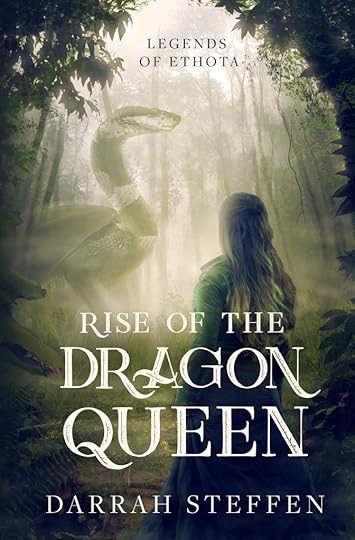Darrah Steffen's Blog, page 8
July 12, 2021
Birthday Myths

July 13th is my birthday. I have made it another year around the sun. So I thought it would be fun to talk about some birthday myths that we celebrate.
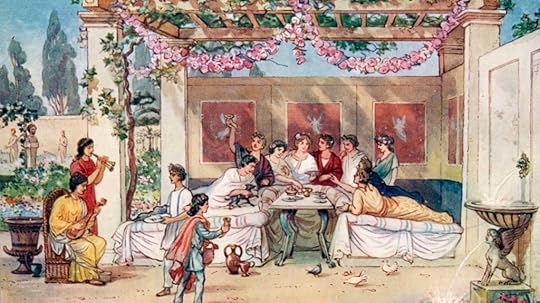 Roman Celebration
Roman CelebrationThe tradition of giving gifts on your birthday can be traced way back to the Romans. They believed that you must appease your “genius.”
The word “genius” had a different meaning to their culture. A genius was personal God or guardian angel. Your genius needed to be respected, especially on birthdays, for them to protect you.
To honor these beings, lavish gifts were given as offerings. Wine, flowers, and incense were popular gifts to appease the genius.
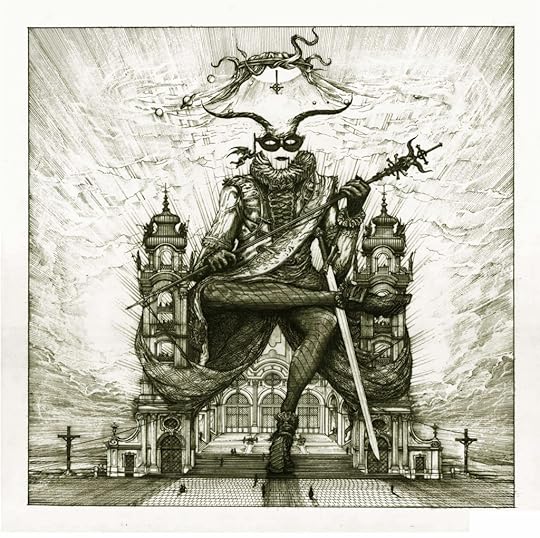
Some countries – like Germany and Russia – believe it is bad luck to wish someone an early birthday. This is thought to be connected to the idea that ghosts return items on their birthday.
Folklore tells of a mischievous spirit that would steal family possessions if someone misbehaved. The item would be returned – if the person was good – the week of their birthday.
 Sugared Primrose Cake
Sugared Primrose CakeThe book The Encyclopedia of Superstitions, Folklore, and the Occult Sciences of the World was published in 1903. It claimed to record superstitions from England and is often considered unreliable.
The book states that if you eat primroses on your birthday, you will be blessed with good luck. It also played on a variation of a King Cake. Rings were baked into the dessert. Whoever found the ring would be next to marry.
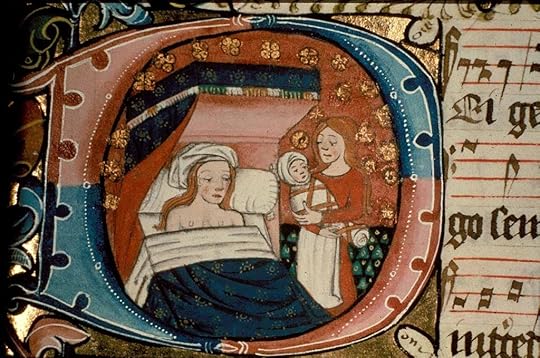 Medieval Birth
Medieval BirthDuring the Medieval Period, births were dangerous. It often led to the death of the mother or child. People did whatever they could to ensure a safe birth.
This included carrying birthing charms. These rituals aided the birth in several ways. The “birthing bag” – which often included a baby’s caul – was used to encourage the baby to come out and to ease the mother’s pain.
Another common ritual was to have the mother eat certain letters out of the palindrome sator arepo tenet opera rotas carved in butter. The phrase means “The sower – with his plow – holds the wheel with care.” This ritual was used to expel a dead fetus or to delay delivery.
 Sun aligning with the Karnak Temple
Sun aligning with the Karnak Temple Finally it was a great honor to have buildings that lined up with the sun on your birthday.
Alexander the Great built Alexandria so the road would line up with the sunrise every year on his birthday. The engineers also perfectly aligned the city, with “The King’s Star,” in the Leo constellation. This star rose close to Alexander’s birthday.

We have taken and changed the traditions over time. But it is fun to see where they started.

This year to “appease my genius” I am putting my book on sale! Be sure to check out “Rise of the Dragon Queen” with its reduced price. This deal is for a limited time only!
Sources:
http://the-history-girls.blogspot.com/2016/05/childbirth-rituals-in-medieval-england.html
https://symposia.library.utoronto.ca
https://www.bustle.com/articles/147073-5-weird-historical-myths-about-birthdays
https://www.babbel.com/en/magazine/birthday-traditions-around-the-world
July 5, 2021
4th of July Myths

It has been 245 years since the United States declared its independence from Great Britain. But still many time-honored patriotic tales are more fiction than fact. What are some myths we believe about our Founding Fathers?
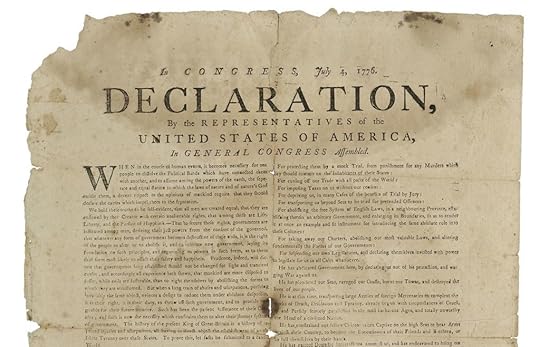
We celebrate US Independence on July 4th. However, this day would have seemed arbitrary to the Founding Fathers.
The Second Continental Congress officially voted for the Declaration of Independence on July 2, 1776. This day is the official date of our independence. However, the written document wasn’t edited and approved until July 4, 1776. This was the date printers affixed to the announcements sent across the land.
Further still, no one signed the Declaration during July. This did not begin until August 2 with John Hancock. The 56 signatures were not completed until late November.

Legend holds that the Liberty Bell cracked after the signing of the Declaration of Independence on July 4, 1776. While U.S. independence sparked celebration for some, the bell was not rung until it cracked. It did ring along with the other bells in the city on July 8th, according to the Pennsylvania Historical and Museum Commission.
The crack had been present since its arrival in 1752. The bell had been poorly cast originally. The bell cracked, was recast, and recast several times in its life. It was determined to be intact during the Revolutionary War.
Today’s crack appeared sometime during the 19th Century. It was as this crack appeared that the bell became known as the Liberty Bell – named by abolitionists.
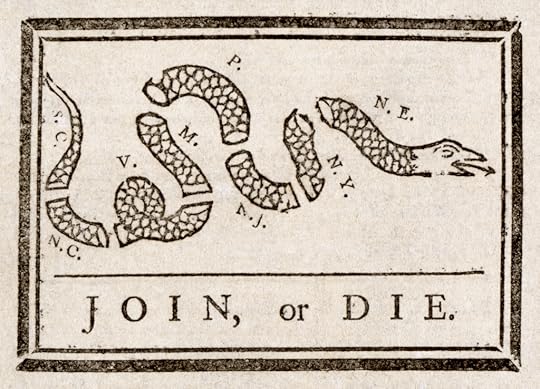 Ben Franklin’s Propaganda
Ben Franklin’s PropagandaStories told today about the American Revolution tell of an underdog fighting against an unbeatable giant. The Revolutionary War also pitted Americans against their neighbors in large numbers. Perhaps 15% to 20% of all Americans remained loyal to the Crown. Many tried to stay neutral.
Records from the time period are spotty, but 50,000 Americans are estimated to have served as British soldiers at one time or another. This is a significant force pitted against the Continental Army that may have included 100,000 regular soldiers over the course of the entire war.
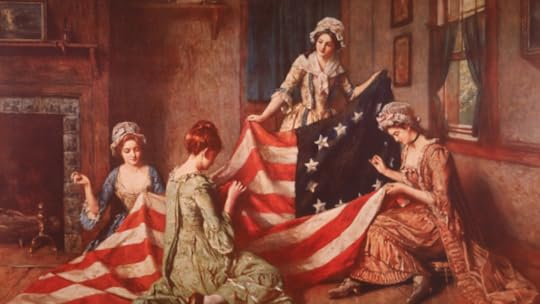 Betsy Ross sewing the first American Flag
Betsy Ross sewing the first American FlagPeople have long credited Betsy Ross as designing and sewing the first American flag that was debuted in 1777. There is no proof either way. And she was thought to be sympathetic to the American cause. So it is possible she was involved in some form.
The story that the famous seamstress was involved never circulated until nearly a century after the fact. Her grandson began spreading the story. Only family tradition remains as evidence.
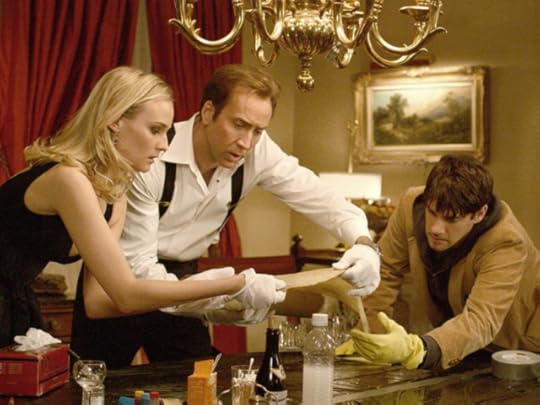 Scene from “National Treasure”
Scene from “National Treasure”Over the years people have thought that the Declaration of Independence holds secret messages. This became very popular after the release of the “National Treasure” movie. The National Archives does admit that there is something written on the back of the document.
A line on the bottom of the Declaration reads: Original Declaration of Independence dated 4th July 1776.
This was most likely written when it was rolled up for storage during travel. The reverse side writing helped the document be quickly identified.
Sources:
https://www.beliefnet.com/love-family/holidays/july-4th/7-myths-about-the-4th-of-july.aspx
June 28, 2021
Summer Solstice Myths

While we might not practice the summer solstice, we have all heard of the ancient observances held at holy places like Stonehenge and Chichen Itza, and seen it played out in pop culture in movies such as Midsommar and plays such as A Midsummer Night’s Dream. But few of us know the meanings of Midsummer and their rituals. Where did these traditions come from?

The summer solstice is celebrated opposite of the winter solstice. The sun is at the height and the day is the longest of the year. This time marked the beginning of the slow and inevitable weakening of the sun over the next half year.
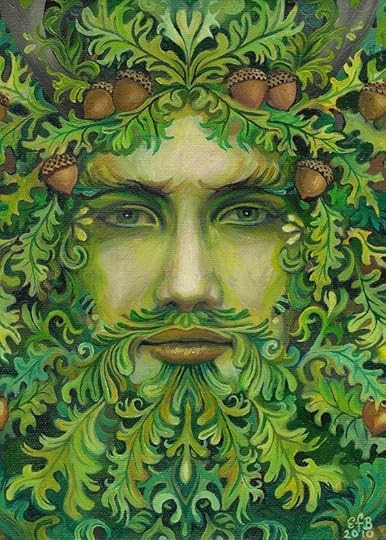 Depiction of the Oak King
Depiction of the Oak KingIn Celtic Mythology, the ancient Oak King is the ruler of summer, light, fertility, and growth. He is the twin brother of the Holly King who rules winter, darkness, and death. These brothers meet for cattle twice a cycle to fight for the Crown of the Year. Every time they meet one is dethroned and the other succeeds.
When the Oak King takes the crown early in the year, the days are long, the crops grow tall and new life is brought into the world.
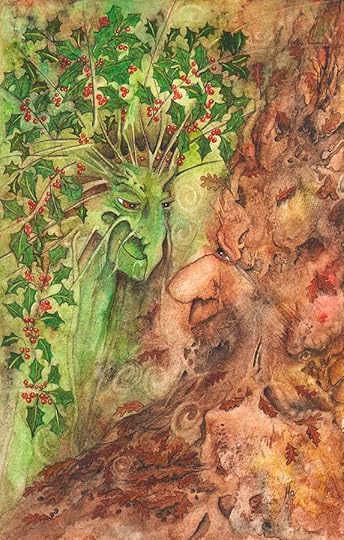 Battle between the Oak and Holly Kings
Battle between the Oak and Holly KingsSome stories state that these epic battles happen on the solstices, while others state the battles occur during the equinoxes. Stating that we see buds appearing, crops germinating, and animals breeding as the Oak King is rising to full power during the Summer Solstice before he weakens and is defeated in autumn.

The main Midsummer Eve rituals centered around fires, both fire and communal. The idea was that the fire, smoke, and ashes would purify environment, driving away the spirits that roamed and protect homes and livestock. Farmers would light fires at home to drift across their fields.
The communal bonfire was lit at nightfall and held a dual role. The first was to purify the environment like the home fires. The other was to stimulate the waning sun to complete the growing season.
 Celebration of Kupala Night
Celebration of Kupala NightMajor transitions in nature never fail to kindle the imagination, producing many traditions. Midsummer Eve was considered one of the nights of the year when the boundaries between the worlds were thin. Spirits were active. During this season animals and crops were susceptible to disease.
Celebrations of Midsummer festival were considered pagan as they centered around the sun and water. In many Slavic countries, this celebration coincided with Kupala Night.
The holiday was considered a pagan fertility rite. Young women weave wreaths and try to tell their fortunes about a future marriages as the flowers float across the water. However, since spirits are also at play, it is important to be careful.
 Releasing wreaths on the Feast of John the Baptist
Releasing wreaths on the Feast of John the BaptistAs Christianity spread across the world, these traditions were coopted by the Church. Kupala Night was converted into the nativity of St. John the Baptist. This adaptation fit both the solar and water themes of the pagan festival and incorporated the pagan beliefs. Like the Oak King, John the Baptist was destined to be murdered as Jesus and the Holly King increased on the Winter Solstice. John worked in water baptisms where Jesus was considered to baptize with the fire of the Holy Spirit.

Over the years, in many places, we have stopped celebrating the summer solstice. However, the traditions remain a rich part of our heritage as well as the mythology behind it.
Sources:
https://mythologymatters.wordpress.com/2015/06/19/summer-solstice-mythology-midsummer-night/
https://nelliecole.com/2020/06/19/folkdays-the-oak-king/
“Guide to Russia” [1]Archived 2017-01-09 at the Wayback Machine
How to Celebrate Kupala Night in Ukraine
June 23, 2021
Jackalope
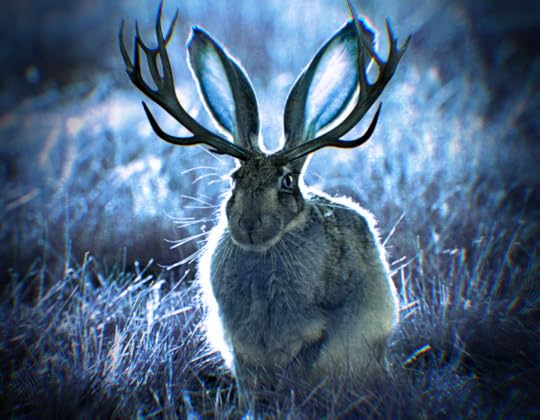
If you travel to any Midwestern state, you will most likely see the bust of a Jackalope for sale. It has become a kitschy souvenir for tourists traveling through. While the busts for sale in the gift shop aren’t real, the animal that inspired it is.
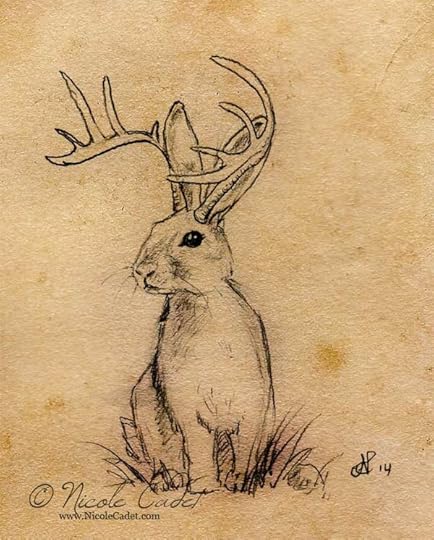
The Jackalope is described as a jackrabbit with the antelope horns. Their popularity started in the 1930’s when taxidermist Douglas Herrick and his brother began selling the busts we still find today. To further their sales they told stories about the mythical creature.
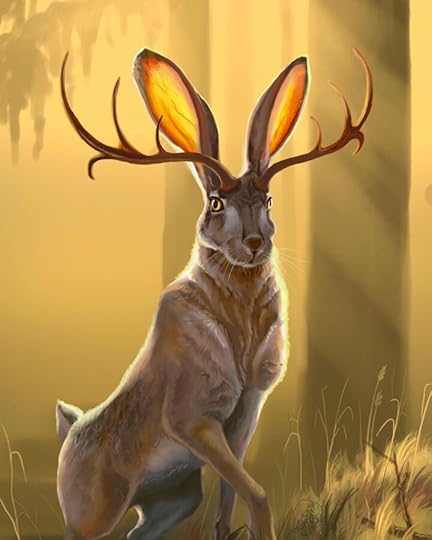
Some of the outlandish tales that have gone along with the Jackalope include the need to wear stovepipe on their legs to prevent the animal from goring you.
Another states you can trap a Jackalope with whiskey, as it is the beverage of choice.
Jackalopes also have the ability to mimic human voices. When cowboys would gather round the campfire and sing, a lone tenor would often join in. This would be the wild Jackalope. It was also said to try to lure cowboys away from their group and leave them stranded in the wilderness.
All these tales notwithstanding, the origins of the Jackalope come from a very real jackrabbit.

The first Jackalopes were determined to be jackrabbits suffering from Shope papilloma virus (SPV). This virus affects rabbits creating keratinous carcinomas that resemble horns. The virus is fatal as the carcinomas affect the animals ability to eat.

The virus was first studied and named in 1933 by Dr. Richard E. Shope in rabbits across the Midwestern United States.
This time line falls exactly with the Herrick Brothers start of the taxidermy Jackalope. They most likely saw the afflicted animals and capitalized on the story.
Sources:
. International Committee on Taxonomy of Viruses. 2014.
Van Praag, Ester (2003). “Do Horned Rabbits Really Exist?- Papillomatosis”. MediRabbit.com.
Delbridge, Rena (2006-12-16). “Chasing the Jackalope”. Casper Star-Tribune. Casper, Wyoming.
Martin, Douglas (2003-01-19). “Douglas Herrick, 82, Dies”. The New York Times. p. 23.
June 14, 2021
Wyvern
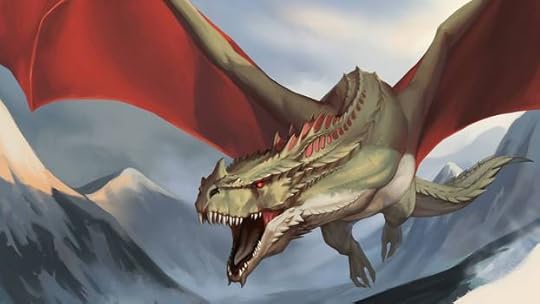
A wyvern is a bipedal, winged dragon usually depicted with a tail ending in an arrow-shaped tip. The wyvern has become very important to heraldry, frequently appearing as a mascot of schools or teams. The wyvern was rarely fire-breathing, unlike the four-legged dragons. But what inspired this strange creature?
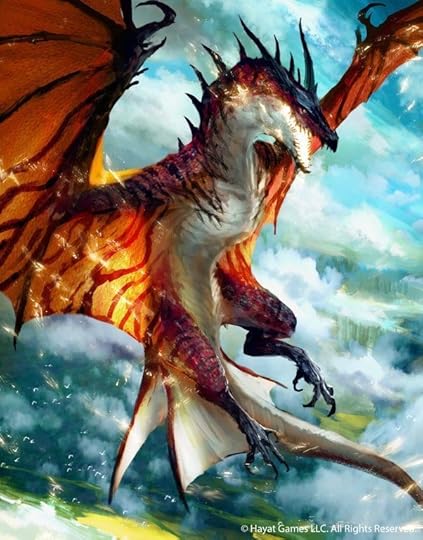
Wyverns are often seen as the smaller, more animalistic variants of dragons. Depictions of dragons that match the wyvern description have been around since Late Antiquity (~235-651 AD), though the term would not be conceived until the early 17th century. The term was used to distinguish the four-legged and two-legged dragons in English and French mythology.
The name Wyvern comes from the Middle English wyver, which in turn comes from the Old North French word guivre meaning poisonous snake. It is also thought the word Wyvern was influenced by the alternative meaning of guivre which means javelin. Medievalist William Sawyers noted similarities between a snake and a javelin fletched in arrows. He concluded that when javelins fell out of favor in the two meanings of the words were melded together into the new word and creature of Wyvern.
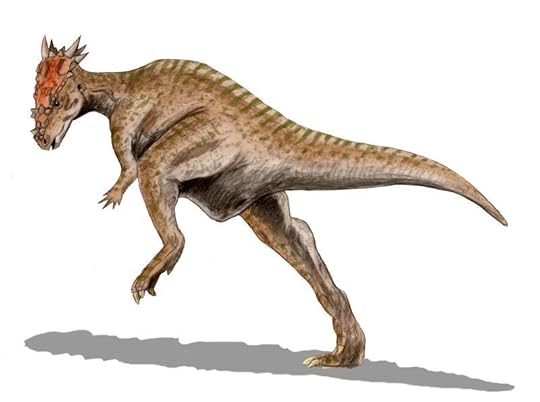
Paleontologists have long believed the myth of dragons originated from ancient civilizations finding dinosaur bones before understanding what they were. The case of the wyvern is no different. The myth of the wyvern has been traced back to a specific animal.
Dracorex hogwartsia literally translates into “The Dragon King of Hogwarts.” With a name like that you can probably tell this specimen was not formally named until 2006. However, it has been around for much longer than that.
 Dracorex skeleton on display in Indianapolis
Dracorex skeleton on display in IndianapolisDracorex belonged to a group called Pachycephalosaurs. These are most commonly recognized as the dinosaurs with domes on their heads and possibly head-butted. Dracorex was found in the Hell Creek Formation of South Dakota.
This animal was a herbivore and had a skull with spiky horns, bumps, and a long muzzle. Unlike others in the group, it had a heavily-armored flat skull.
 Typical depiction of a Wyvern
Typical depiction of a Wyvern Typical depiction of Dracorex
Typical depiction of DracorexThe horns and nodes along the skull of this creature look very similar to how dragons and wyverns are typically depicted. The short arms of the Dracorex could be easily seen as winged arms like bats. The length of the body can be up to 4.5 m. With its round body and slender tail, the size of the creature could easily been seen as a nightmarish monster.
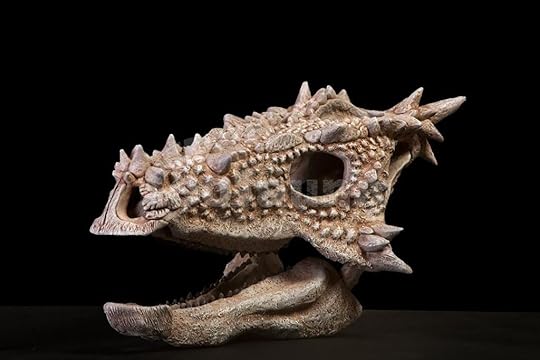 Dracorex skull
Dracorex skullOn a side note, biologically, wyverns make the most sense for a dragon form. In the animal kingdom, if an animal gains powered flight, they typically lose the use of their front limbs. The front limb merges with the wing. This can be seen in bats and birds.
The image of a typical dragon with the four individual limbs as well as two wings would not happen if it were to naturally evolve. Wyverns also typically do not breathe fire. While many animals have biologic defenses such as spitting acid, fire breathing has not been seen as there is no source within a creature’s body to pull from.
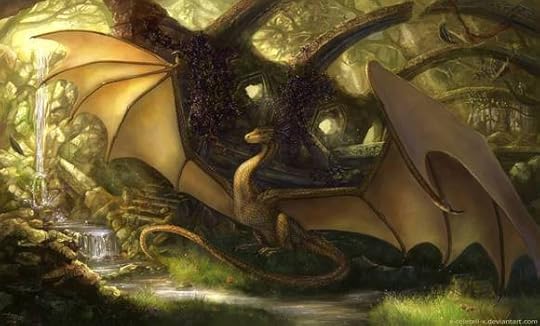
The mythology of wyverns is fascinating and the creature that inspired them is even more so.
Sources:
https://dragons.fandom.com/wiki/Wyvern
https://www.childrensmuseum.org/blog/meet-dracorex-hogwartsia-v2
June 8, 2021
Incubus and Succubus
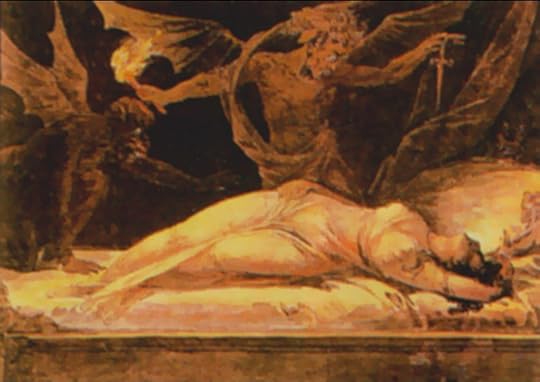 Incubus, 1879
Incubus, 1879The incubus and succubus are demons who lie upon sleeping persons in order to engage in sexual activities with then. Repeated assaults with these demons result in deterioration of health, impared mental state, and even death. Salacious tales of incubi and succubi have been told for centuries. But where did these creatures come from?
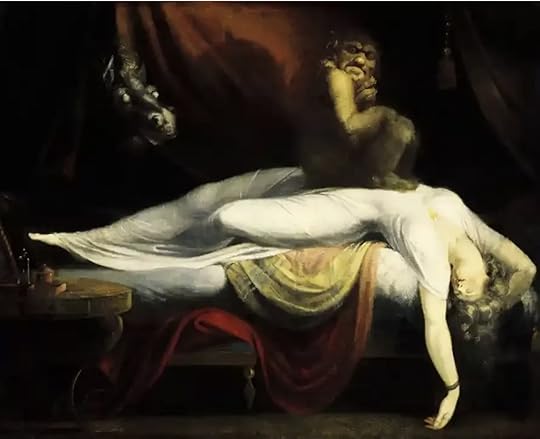 The Nightmare, 1781
The Nightmare, 1781The word incubus is derived from the Latin incubare meaning “to lie upon.” One of the earliest mentions of this creature came from Mesopotamia. The hero of Gilgamesh’s father is listed a Lilu. It is said that Lilu disturbs and seduces women in their sleep, impregnating them.
While religions have debated the possibility of these sexual demons for many years, the actual origins are based in science. Many scientists agree that the foundation for the myth of incubi and succubi comes from sleep paralysis.

We usually think of being asleep or awake as clearly defined states. However, conditions like sleep paralysis muddy the waters. Episodes involve elements of both sleep and wakefulness, which is why distressing symptoms arise.
Sleep paralysis is a condition identified by a brief loss of muscle control that happens just after falling asleep or waking up. In addition, people often experience hallucinations and difficulty breathing during episodes of sleep paralysis.
Sleep paralysis is connected to the rapid eye movement (REM) stage of the sleep cycle. A standard REM sleep involves vivid dreaming as well as atonia – or loss of muscle control. This prevents you acting out the motions of the dream. Under normal circumstances, atonia ends upon waking, so the person never becomes aware of this inability to move.
During sleep paralysis, wakefulness blends with REM sleep. In effect, the atonia and mental imagery of REM sleeps seems to persist even into a state of being aware and awake.
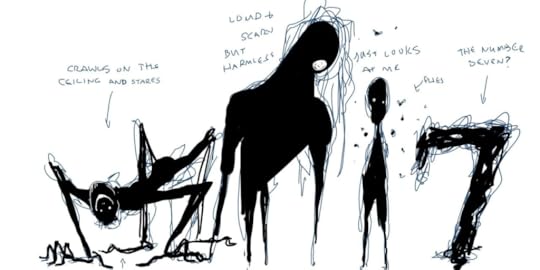 Common hallucinations seen during sleep paralysis
Common hallucinations seen during sleep paralysisAn estimated 75% of episodes involve hallucinations that are distinct from typical dreams. Episodes can last a few seconds to 20 minutes. Most are reported being around seven minutes in length. The episodes usually end by themselves but can be interrupted by another person as well. The hallucinations during sleep paralysis fall into 3 categories:
Intruders – which involve perceiving a dangerous presence in the roomChest pressure – also called incubus hallucinations – that can incite the feeling of suffocations. These often coincide with the intruder.Vestibular-motor – which can include feelings of flying or out of body sensationsThe exact cause of sleep paralysis is unknown. Higher rates of sleep paralysis are reported by people also being treated for obstructive sleep apnea (OSA) – a sleep disorder of repeated lapses in breathing. It has also been found to be common in people with nighttime leg cramps. Other studies have found that people who show traits of imaginativeness and disassociating from their environment are more likely to experience sleep paralysis. There seems to be a link between it and vivid nightmares and/or lucid dreaming.
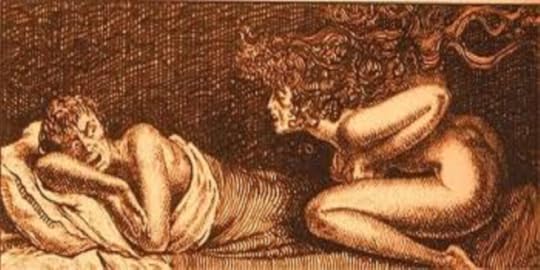
Sleep paralysis has been plaguing people for centuries. It is a strange occurrence that has led to stories of ghosts, demons, and even aliens. Due to the strange intruder and chest pressure hallucinations, it is not that far of a stretch to see how it led to the incubus and succubus stealing your lifeforce as you sleep.
Sources:
Stephens, Walter (2002), Demon Lovers, p. 23, The University of Chicago Press
May 31, 2021
The Sphinx
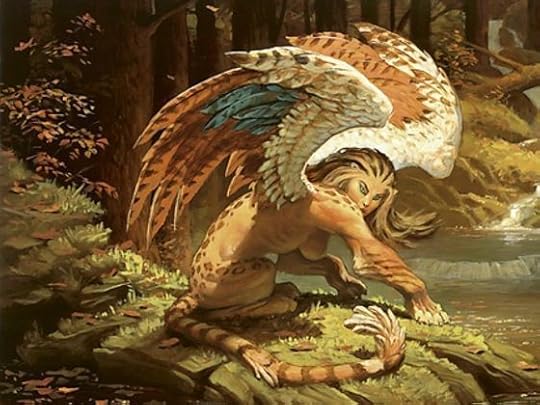
Only one color, but not one size.
Stuck at the bottom, yet easily flies.
Present in sun, but not in rain.
Doing no harm, and feeling no pain.
A sphinx is a mythical creature with the head of a human, the body of a lion, and the wings of a falcon. She is said to be merciless and will kill those who cannot answer her riddles.
The most well known Sphinx is the Great Sphinx of Giza. However, this sphinx shows the face of a man. It is also told to be a benevolent guardian but showing similar strength. But what inspired these strange creatures?
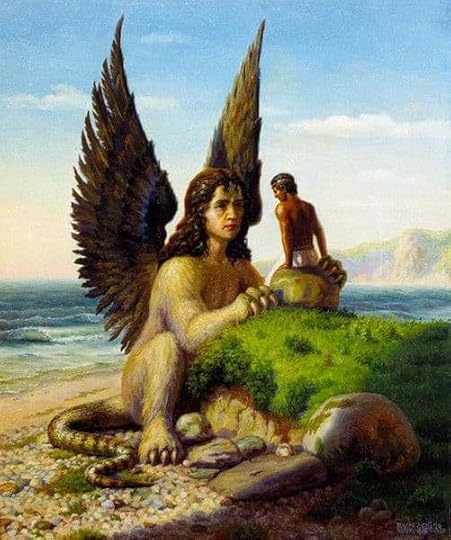 The Sphinx with Oedipus
The Sphinx with OedipusThe Sphinx is a hybrid creature similar to a griffin or chimera. As previously discussed, the idea of the griffin sprang from the broken skeleton of a Protoceratops. The idea of the Sphinx is thought to be derived from a similar – perhaps larger – creature, found without a skull.
Without the skull, the persons finding the skeleton were free to interpret the head as they saw fit. It was often placed with a woman’s face. This could be due to the gracile nature of the skeletons.
 The Sphinx of Giza
The Sphinx of GizaThe Egyptian Sphinx is not considered a true Sphinx. This is mainly because of the male face that was placed on the body after Pharaoh Khafre. It also lacks wings which further muddies the traditional mythology. The Giza Sphinx is often called an androsphinx because of this.
It is believed that Pharaoh Khafre is responsible for the Great Sphinx, but no one knows for sure. The pharaoh is credited with the second largest pyramid in the Giza Necropolis. The proximity of this pyramid – called the Pyramid of Khafre – is responsible for the connection as well as certain similarities in the face to monuments of Khafre.
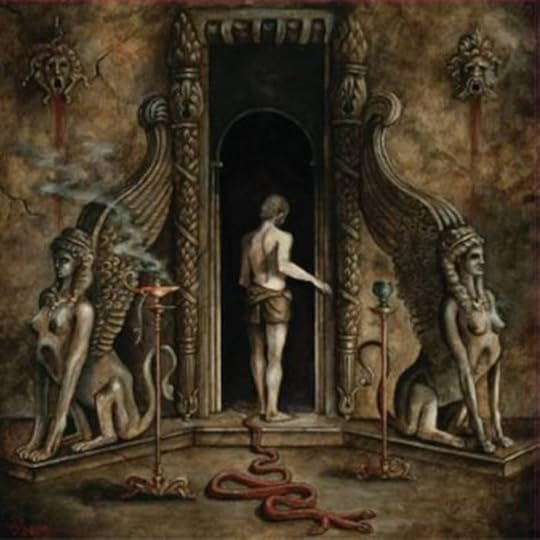 Sphinx Temple
Sphinx TempleThe word sphinx comes from the Greek word sphingo – which means to strangle. The Greek Sphinx was malevolent and associated with strength and trickery. When the passerby couldn’t answer the riddle, the sphinx would strangle them.
As the myth of the sphinx evolved it became associated with protection, mystery, strength, and wisdom. This is why is is most often seen depicted outside tombs. It is no surprise that overtime a cult developed to worship this creature.
During the reign of Pharaoh Thutmose IV, the sphinx was unburied from the sand. He introduced a religion connecting the Sphinx with the sun god – Harmakhet. Statues, paintings, and reliefs of the figure popped up across the country. The Sphinx became a symbol of royalty and the power of the sun.
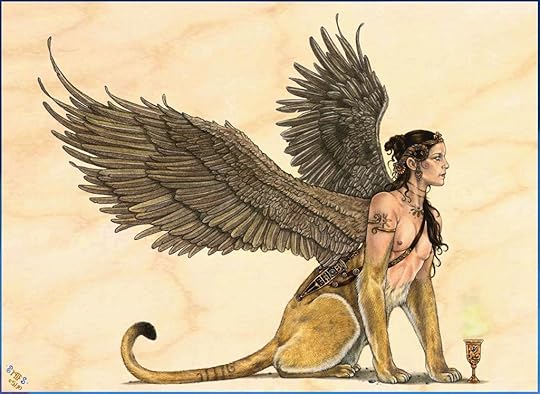
Mythology changes and grows as it passes through the lenses of different cultures. You can see that in how the Sphinx has changed. It likely started as a story based on a broken skeleton and evolved into the oldest known monument in the world.
Sources:
https://www.mentalfloss.com/article/67668/15-things-you-might-not-know-about-sphinx
https://www.history.com/topics/ancient-egypt/the-sphinx
https://www.smithsonianmag.com/history/uncovering-secrets-of-the-sphinx-5053442/
May 23, 2021
The Mythology Anthology
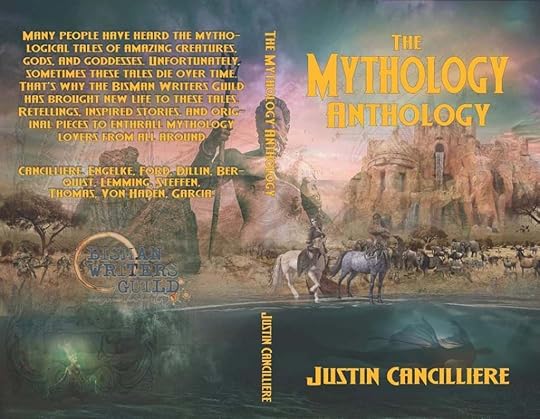
BIG NEWS!
The BisMan Writer’s Guild is releasing its second full length anthology featuring authors around North Dakota.
BisMan Writer’s Guild was started in Feb. of 2019. Their mission is to uplift local authors throughout North Dakota by promoting, advancing, and supporting them. They offer workshops, share the works of others, and shed light on the amazing talent of our state. The Guild works hard to bring workshops, write-ins, general get-togethers, give writers an opportunity to be published in anthologies.
The theme of this anthology – releasing on June 12th – is Mythology. From the world of Greek gods to the strange worlds created by authors, everything has been included in this anthology. See your favorite tales told with a new flair!
You can also join us for the Release Party on June 12!

May 22, 2021
The Griffin
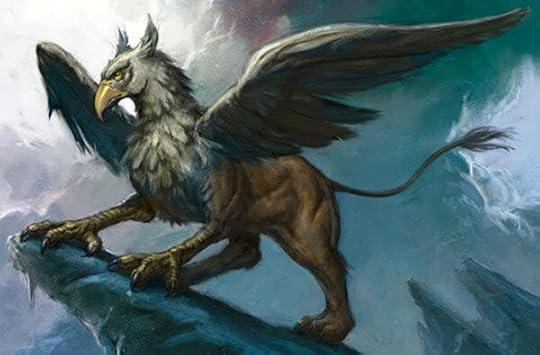
The Griffin is a legendary creature that is half lion and half eagle. Representations of griffins appeared in Ancient Iran and Egypt as far back as 3000 B.C. Because the lion was seen as the king of the beasts and the eagle was seen as the king of the birds, the Griffin was thought to be an especially powerful and majestic creature. Griffins were known for guarding treasures and priceless possessions.
But where did this creature come from?
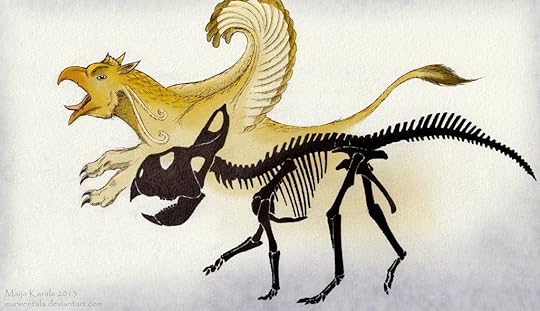 Griffin vs Protoceratops skeleton
Griffin vs Protoceratops skeletonThe myth of the griffin is thought to be based on finding broken skeletons of Protoceratops in Mongolia.
Protoceratops is an early Ceratopsian dinosaur that lived 75-72 million years ago. It was well suited to live in the deserts, eating vegetation and possibly even eggs. It had a small frill covering its head with large holes.
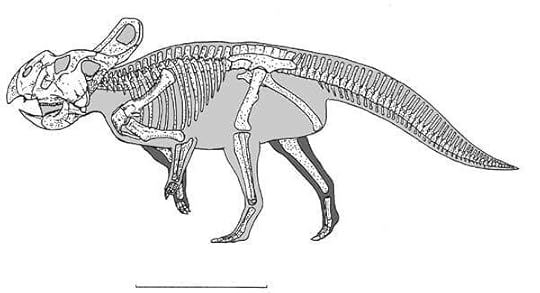
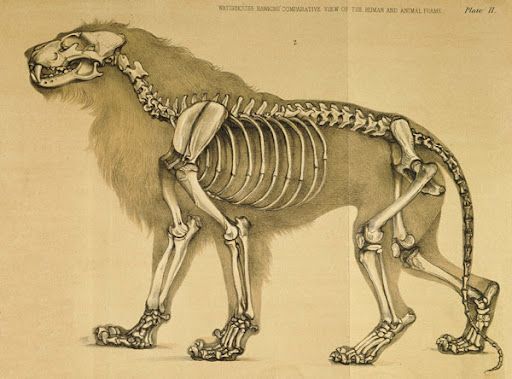
The Protoceratops was officially discovered and named in 1923 by American Roy Andrew Chapman. However, these skeletons would have been appearing to the locals for centuries before that.
It is hypothesized that the fragile frill of the Protoceratops fractured, leading people to believe this creature had large ears or horns. The beak resembled a large bird, inspiring the eagle. The body of the dinosaur could be mistaken for a lion-like creature. The claws on the feet would have been attributed to the eagle once more. The long shoulder blades on the Protoceratops were attributed to wings or wing attachments.
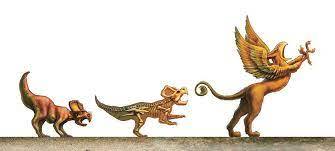 Transformation to the Griffin
Transformation to the GriffinThe Protoceratops Hypothesis was first proposed in 1993 by Adrienne Mayor and Michael Heaney. This is one of the clearest paths that show how a mythical creature has been created from a real world creature.
Sources:
https://www.amnh.org/exhibitions/mythic-creatures/land/griffin-bones
“Protoceratops”. Dallas Museum of Natural History.
Longrich, Nick (2010). “The Function of Large Eyes in Protoceratops: A Nocturnal Ceratopsian?”. In Ryan, Michael J.; Chinnery-Allgeier, Brenda J.; Eberth, David A. (eds.). New perspectives on horned dinosaurs : the Royal Tyrrell Museum Ceratopsian Symposium. Indiana University Press. pp. 308–327.
Vote for “Rise of the Dragon Queen”
For the past month, “Rise of the Dragon Queen” has been making its way through the AllAuthors Cover Contest.
We have made it to the final round. Only the top 3 book covers win.
Help my amazing cover artist and me get to the final 3. Click the link below and vote for “Rise of the Dragon Queen.”
*It may ask you to login to vote.
Vote Here